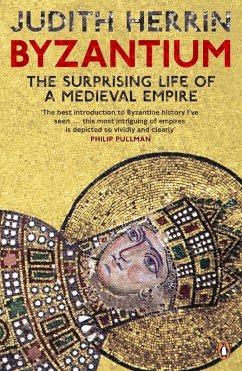For a thousand years an extraordinary empire made possible Europe's transition to the modern world: Byzantium. An audacious and resilient but now little known society, it combined orthodox Christianity with paganism, classical Greek learning with Roman power, to produce a great and creative civilization which for centuries held in check the armies of Islam.
Judith Herrin's concise and compelling book replaces the standard chronological approach of most histories of Byzantium. Instead, each short chapter is focused on a theme, such as a building (the great church of Hagia Sophia), a clash over religion (iconoclasm), sex and power (the role of eunuchs), an outstanding Byzantine individual (the historian Anna Komnene), a symbol of civilization (the fork), a battle for territory (the crusades). In this way she makes accessible and understandable the grand sweeps of Byzantine history, from the founding of its magnificent capital Constantinople (modern Istanbul) in 330, to its fall to the Ottoman Turks in 1453.
Judith Herrin's concise and compelling book replaces the standard chronological approach of most histories of Byzantium. Instead, each short chapter is focused on a theme, such as a building (the great church of Hagia Sophia), a clash over religion (iconoclasm), sex and power (the role of eunuchs), an outstanding Byzantine individual (the historian Anna Komnene), a symbol of civilization (the fork), a battle for territory (the crusades). In this way she makes accessible and understandable the grand sweeps of Byzantine history, from the founding of its magnificent capital Constantinople (modern Istanbul) in 330, to its fall to the Ottoman Turks in 1453.
Dieser Download kann aus rechtlichen Gründen nur mit Rechnungsadresse in A, B, BG, CY, CZ, D, DK, EW, E, FIN, F, GR, HR, H, IRL, I, LT, L, LR, M, NL, PL, P, R, S, SLO, SK ausgeliefert werden.

Wie bringt man das byzantinische Reich, diesen schillernden historischen Monolith zwischen Antike und Neuzeit, dem gewöhnlichen Leser nahe? Altmeister der Byzantinistik wie Georg Ostrogorsky und Steven Runciman, aber auch der deutsche Historiker Ralph-Johannes Lilie haben es mit Ereignisgeschichte versucht: der Darstellung der (Bürger-)Kriege, Thron- und Glaubenskämpfe, die das tausendjährige Imperium am Bosporus schufen und zerstörten. Judith Herrin, Byzantinistin am King's College in London, wählt in ihrem 2007 erschienenen und jetzt ins Deutsche übersetzten Band dagegen eine mehr kaleidoskopische Erzählweise. In achtundzwanzig kurzen Kapiteln erzählt sie von der Kunst, Architektur, Ökonomie, Theologie und Politik Ostroms, von seinen Tischsitten und Militärtechniken, seinem hohen Bildungsstand und seiner stupenden Toleranz gegenüber den Sitten und Gebräuchen der vielen christlichen Völker, die sich auf den Straßen seiner Städte mischten. Aber der panoramatische Blick, den die Autorin auf das mit vielen schönen Anekdoten und Zitaten ausgeschmückte Gewimmel wirft, ist zugleich die große Schwäche ihres Buches. Denn Herrins historische Skizzen wirken oft oberflächlich und inkohärent, und hier unterlaufen ihr auch sachliche Fehler, die ihre Autorität schmälern. Es stimmt eben nicht, dass der Streit zwischen Byzanz und den Ottonen um das römische Kaisertum nur ein "Geplänkel über Titel" war, und auch der Große Palast am Hippodrom war keineswegs bis zur türkischen Eroberung von 1453 intakt. So bleibt Herrins Studie ein Mittelding: Den interessierten Laien blendet und verwirrt sie, und dem Fachmann hat sie wenig zu bieten. (Judith Herrin: "Byzanz. Die erstaunliche Geschichte eines mittelalterlichen Imperiums". Reclam Verlag, Stuttgart 2013. 416 S., geb., 29,93 [Euro].)
kil
Alle Rechte vorbehalten. © F.A.Z. GmbH, Frankfurt am Main

